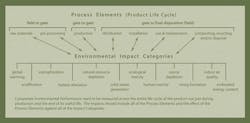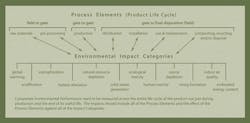Looking at Product Life-Cycle Assessments
With unclear and inconsistent definitions and principles being tossed about regarding sustainability, Hazleton, PA-based Forbo Flooring Systems' 1. sus•tain reference guide may help you better understand how important independent, reputable sources and third-party, peer-reviewed methodologies are when making product choices. Following is some advice that Forbo offers ...
The best way to establish that the products you're looking at have been independently reviewed is to make sure that the manufacturers you're considering conduct an ISO-compliant life-cycle assessment (LCA). A life-cycle assessment is the full assimilation of the environmental impact of a product, process, or service throughout its lifespan. A manufacturer should establish the full impact that its products and processes have on the environment - this is known as an "environmental footprint" - and that information should be available to you as you shop around. Don't be afraid to ask for it.
The term "life-cycle" refers to a fair, holistic assessment that requires the analysis of all process elements, including raw materials extraction (substances used in manufacturing), processing, manufacturing, distribution, use, and end-of-life outcome, including all steps of transportation. This is the life-cycle of the product.
The Intl. Organization for Standardization (ISO) has developed environmental-management standards (ISO 14000) that incorporate LCA protocol (ISO 14040). These standards describe the principles and framework for life-cycle assessment.
An accurate life-cycle assessment measures a product's environmental footprint - throughout its entire life - against 12 environmental impact categories (EICs): global warming, acidification, eutrophication (an increase in chemical nutrients), habitat alteration, natural resource depletion, solid waste generation, ecological toxicity, human toxicity, ozone depletion, smog formation, indoor air quality, and embodied energy content.
A bio-based product's life-cycle can be organized into three categories that cover seven process elements (raw materials, pre-processing, production, distribution, installation, use and maintenance, and composting, recycling, and/or disposal):
- Field to Gate covers the processes of raw material acquisition and pre-processing. These process elements, generally involving companies and suppliers beyond the manufacturer, are often overlooked when manufacturers state their environmental impact. It may be hard for you to find. Keep that in mind as you're making decisions about products.
- Gate to Gate covers the impacts within a manufacturer's facility. This is the easiest for a manufacturer to control; usually, this information is made available to the public.
- Gate to Field/Final Disposition covers the distribution, installation, use and maintenance, and end-of-life outcome. Impacts here are often represented as life-cycle costing, yet life-cycle costing only measures financial, non-environmental impacts.
The effects of the seven process elements are measured equally against the 12 EICs. The cumulative impact forms the full life-cycle assessment.
When you're searching for products, ISO-compliant LCAs should be the basis of the environmental certification or label, and can be used for accurately comparing materials.

